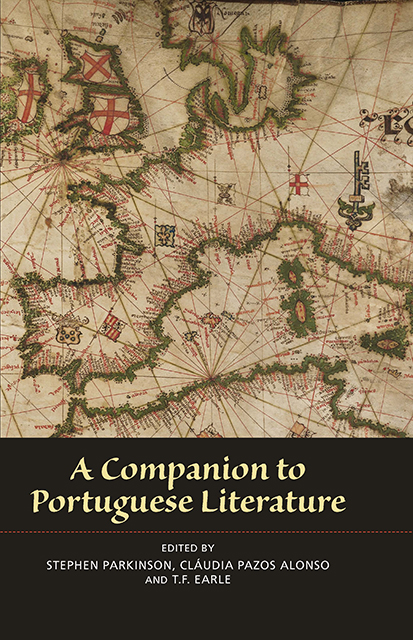Book contents
- Frontmatter
- Contents
- Acknowledgements
- Notes on the Contributors
- Introduction
- 1 Eight Centuries of Portuguese Literature: An Overview
- 2 The Medieval Galician-Portuguese Lyric
- 3 Fernão Lopes and Portuguese Prose Writing of the Middle Ages
- 4 Portuguese Theatre in the Sixteenth Century: Gil Vicente and António Ferreira
- 5 The Lusiads and the Literature of Portuguese Overseas Expansion
- 6 Lyric Poetry in the Sixteenth Century
- 7 The Seventeenth Century
- 8 The Eighteenth Century
- 9 Almeida Garrett: Founder of Modern Portuguese Literature
- 10 The Transition from Romanticism to Realism: Alexandre Herculano, Camilo Castelo Branco and Júlio Dinis
- 11 Eça de Queirós: A European Writer
- 12 Fernando Pessoa and the Modernist Generation
- 13 Narrative and Drama during the Dictatorship
- 14 Women Writers up to 1974
- 15 Writing after the Dictatorship
- 16 Portuguese Literature in English Translation
- Index
6 - Lyric Poetry in the Sixteenth Century
Published online by Cambridge University Press: 03 March 2023
- Frontmatter
- Contents
- Acknowledgements
- Notes on the Contributors
- Introduction
- 1 Eight Centuries of Portuguese Literature: An Overview
- 2 The Medieval Galician-Portuguese Lyric
- 3 Fernão Lopes and Portuguese Prose Writing of the Middle Ages
- 4 Portuguese Theatre in the Sixteenth Century: Gil Vicente and António Ferreira
- 5 The Lusiads and the Literature of Portuguese Overseas Expansion
- 6 Lyric Poetry in the Sixteenth Century
- 7 The Seventeenth Century
- 8 The Eighteenth Century
- 9 Almeida Garrett: Founder of Modern Portuguese Literature
- 10 The Transition from Romanticism to Realism: Alexandre Herculano, Camilo Castelo Branco and Júlio Dinis
- 11 Eça de Queirós: A European Writer
- 12 Fernando Pessoa and the Modernist Generation
- 13 Narrative and Drama during the Dictatorship
- 14 Women Writers up to 1974
- 15 Writing after the Dictatorship
- 16 Portuguese Literature in English Translation
- Index
Summary
The sixteenth century is especially rich in poetry of high quality. This was a time when poets were open to a great variety of influences, in several languages, which must have stimulated their ambition. It was also the time when the maritime empire in Africa and Asia reached its peak, and great events have a tendency to inspire great minds.
These were years when Portuguese literary culture was open to the world, but still very much in touch with its popular and medieval roots. A classic example of the presence of the past in the Renaissance period, given in all literary histories, is the Cancioneiro Geral (General Songbook), a huge compilation in several volumes of the lyric and satirical poetry of the fifteenth century, published by the poet and courtier Garcia de Resende in 1516. It was an important moment in the history of the traditional lyric, but not its end. Many writers of the sixteenth century, including Sá de Miranda and Camões, continued to write using the poetic forms and the five- or seven-syllable metre which had been popular in Portugal and Spain the century before.
However, not long after 1516 the Italian Renaissance came to Portugal, in the sonnets, the first to be written in Portuguese, of Francisco de Sá de Miranda. He spent the early 1520s in Italy, principally in Rome, as a member of the household of the Portuguese ambassador to the Holy See. In the years before the terrible sack of 1527 the city was going through one of its most brilliant periods as a centre of art and literature, and the young foreign poet was in the right place at the right time.
The sonnet was not just a new poetic form for the Portuguese; it also involved a new metre. The decasyllable used in sonnets was based on the Italian model, and had, unlike the medieval metres, a constant stress pattern, with a marked stress on the sixth syllable (or less frequently on the fourth), as well as on the tenth. The decasyllable greatly increased the musicality of poetry, while the new forms of sonnet, canzone (in Portuguese, canção), and eclogue made possible much more ambitious literary structures.
- Type
- Chapter
- Information
- A Companion to Portuguese Literature , pp. 85 - 96Publisher: Boydell & BrewerPrint publication year: 2009



